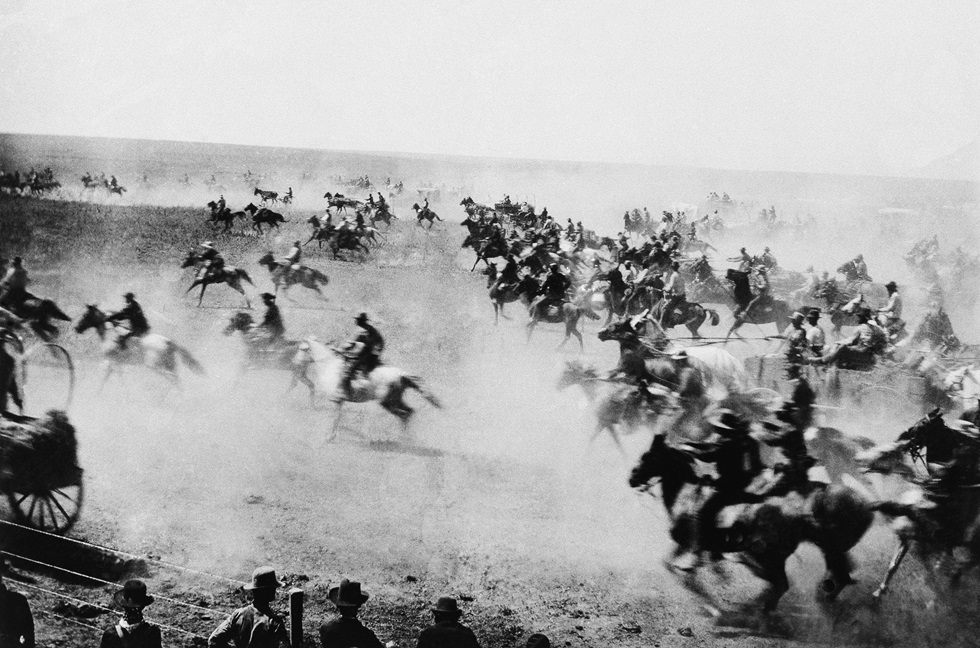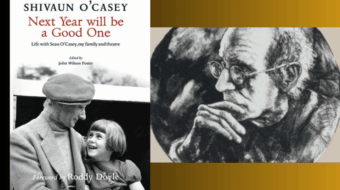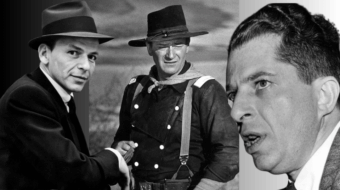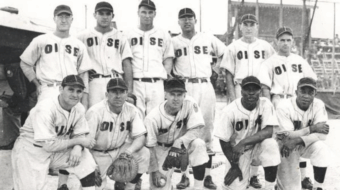
The year is 1823, and the Marshall Supreme Court has issued the decision of McIntosh v. Johnson, which set the ignominious standard of Federal Indian Law that remained alive and kicking through the late 20th century. It also laid the groundwork for the expropriation of Indigenous land in the early 1900s, culminating in the massive dispossession of the Five Tribes of Eastern Oklahoma—Cherokee, Muscogee Creek, Chickasaw, Choctaw, and Seminole.
(I have elected to use the term Five Tribes rather than Five Civilized Tribes as the latter colonial name refers to a racist belief that these Indigenous nations had adopted Euro-American culture en masse and was first used by the federal government just after the Civil War. Further, the term implies that other Indigenous nations were not “civilized.”)
The long-term effects of land dispossession have been aptly and poignantly described by ground-breaking Chickasaw attorney Helen Nowlin, who, taking the initiative in bringing long-needed attention to this century-long loathsome injustice, states as follows:
“Land ownership is at the heart of intergenerational wealth-building or lack thereof. Those who are the direct beneficiaries of the theft of NDN land and the intergenerational wealthy denied to the legal heirs have a debt to pay. I ask, why are there homeless NDNs? Where were the tribal governments as the allottees’ lands were illegally converted, and where are the tribes now for the individual NDN heirs?”
Nowlin further states in reference to land theft: “They were also dispossessed by brutality, outright ejectment to force Indian families off their land while proclaiming the family had deserted the land.”

But a step must be taken back in time to see how this iniquitous result came to fruition. A further look must be directed at the Marshall decision and how it endured, with its use even employed by an otherwise considered liberal Supreme Court justice in the late 20th century.
This long-living nefarious criteria was based on the anachronistic “Doctrine of Discovery.” Marshall reached deep into the cobweb-laden dustbin of history to bring this so-called Doctrine back to life. Even in its heyday, it had its own powerful detractors.
“Doctrine of Discovery” and the Spanish tradition
A historical investigation is merited by the deleterious role it has played through the ages. This will begin with the opposition to the Doctrine led by one of the leading Spanish legal authorities of the day, Francisco de Vitoria. In fact, Vitoria was considered the most important Spanish legal theorist of his day on the rights of the Natives of the Americas.
His lectures and legal reasoning brought him recognition as an authority of Spanish legal colonial theory as applied to Indigenous colonized peoples in the 16th century. It has been even opined that Vitoria’s views influenced modern international law as well as United States jurisprudence.
Mention must also be made of a historical tragedy contemporaneous with the issuance of the Papal Bull establishing the so-called Doctrine of Discovery, which was the Spanish conquest of the Guanches, the Indigenous people of the Canary Islands, located off the northeast coast of Africa.
The Papal Bull was issued in 1493, and the Spanish conquest concluded in 1496. It could be said that this conquest was a striking parallel with, indeed even a precursor of, the Spanish conquest of the Indigenous peoples of the islands of the Caribbean. The same atrocious brutality, the same enslavement, the same resistance, the same population collapse caused by European diseases, the same genocide—all were traits of both ruthless invasions, with perhaps even more extreme atrocities employed against the Indigenous of the area now called the West Indies.
There are some writers who opine that the Spanish decimation of the Guanches signaled the rise of imperialism. However, other studies more definitively establish that the imperialist system, indeed, did not emerge until the late 19th century from the depths of monopoly capitalism in western Europe.
But, now back to Vitoria. His ideas heavily contributed to Enlightenment-era views on the Law of Nations as a system of international law mutually binding on all the nations that remained essentially in a so-called “state of nature” (whatever that meant). He postulated three arguments that were later reflected in the European Law of Nations in opposition to any Doctrine of Discovery as follows:
1.) The inhabitants of the Americas possessed natural legal rights as free and rational people;
2.) Any Spanish claims to title to the Americas on the basis of Discovery or papal grant were illegitimate and could not affect the inherent rights of the Indian inhabitants;
3.) Transgressions of the universal norms of the Law of Nations by the Indians might to justify a Christian nation’s conquest and colonial empire of the Americas.
Suffice it to say that Vitoria’s exposition leaves a considerable diminution of justice to be adopted in his third reasoning argument, but what is most important is its opposition to possession by discovery. Discovery and papal grants were illegitimate.
Vitoria’s position that the Indigenous peoples of the Americas had rights under natural law was based on the assertion that the Indians were rational beings and therefore possessed the same natural rights as Christians. With regard to their lands and possessions they had in the so-called New World, the Indians were the “true owners alike in public and private law before the advent of the Spaniards among them.” Vitoria contended that “just like Christians, neither their princes or private persons could be despoiled of their property” without just cause.
The only just cause that could be asserted for dispossessing the Natives of their lordship or property by Vitoria’s standards was an evident lack of reason on their part. But still, exactly what did he mean? Nonetheless, he continued to discount the Doctrine of Discovery.
Vitoria dismissed the then somewhat popular theory of “title by first discovery,” arguing that by natural law, the Indigenous were free and were therefore the “true owners” of the lands they possessed as follows:
“Not much however, be said about this title of ours, because as proved above, the barbarians were the true owners, both from the public and private standpoint. Now the rule of the law of nations is that what belongs to nobody is granted to the first occupant, as is expressly laid down in the Roman Institutes. And so, since the land in question was not without an owner, it does not fall under the title which we are discussing. By itself, it gives no support to a seizure of the aborigines any more than if it had been they who had discovered us. “
However, the consequences under certain circumstances could also result in the divestiture of Indigenous possession, nonetheless. Who knows what course history would have taken by the adoption of Vitoria’s legal theory?
But Vitoria made complete sense in his position on the Pope’s decrees. As for the Papal Bulls affirming the “discoveries” of Columbus, Vitoria asserted that according to natural law, the Pope has “no temporal power over the Indian aborigines or other unbelievers” and his asserted superior rights of dominion were wholly “baseless.” Flying in the face of the Requerimiento, Vitoria contended that “even if the barbarians refuse to recognize any lordship of the Pope, that furnished no ground for making war on them and seizing their property.”
The Indians were free according to natural and divine law, and no human law, whether issued by priest or king, could bind them without their consent. Such a law “would be void of effect, in as much law presupposes jurisdiction…. The law could not bind one who was not previously subject to it.”
Vitoria’s last argument on Indigenous rights was that the people of the Americas, although free according to Natural Law, were nonetheless subject to the binding Law of Nations that itself was based on natural law.
Needless to say, the early invading European colonists, even if they were aware of the argument for or against the Doctrine of Discovery, made no mention of the deleterious dogma. Instead, they obtained Indigenous lands by purchase or treaty. In other instances, the avaricious colonists reverted to fraud, duress, or outright power grab confiscation of Indigenous lands. But never was there any reliance or even any mention of the Doctrine of Discovery. There was the practice, for the most part, of seeking Indigenous consent for land cessions.
The United States, in breaking from English rule, asserted that it inherited the policy of England toward Native nations. But the British Crown never advanced the Doctrine of Discovery in its relationships with Indigenous polities. So, how could the newly-minted United States inherit such a doctrine from Great Britain? The answer is it could not.
The infamous Doctrine was first plucked from the medieval dustbin of history by Marshall to become ensconced in U.S. law and assumed a judicial life of its own. The case adopted as a foundational principle that the Indigenous peoples had only a right of occupancy which could be extinguished by the European discoverer/invader/occupier either by purchase or conquest. The invader had the exclusive prerogative to exercise that right. Title was vested in the foreign power. This was a perversion of the legal stance of Vitoria.

Oklahoma dispossession
Fast forward without further adieu over the decades, and history finds itself confronted with the dispossession of the Five Tribes of Eastern Oklahoma. The Doctrine of Discovery hauntingly looked over the shoulders of the federal government as it performed its divestiture dance destroying the Native republics, whose lands were enshrined in the forever-sacred treaties.
Implicit in the illegal machinations of the federal government was the ever-present specter of the heinous Doctrine of Discovery. Foremost among these oppressor-driven measures was the ignominious rise of the settler state of Oklahoma. This settler state of the union arose on the backs of it most vulnerable—the Five Tribes of Eastern Oklahoma.
This ascendancy and its accompanying tragedy were exposed in a report written in 1924 by Lakota activist Zitkala-Sa, a.k.a. Gertrude Simmons Bonnin and others. The report, entitled Oklahoma’s Poor Rich Indians: An Orgy of Graft and Exploitation of the Five Civilized Tribes – Legalized Robbery, is a narrative of the most venal exposition of legalized land robbery in U.S. history.
The research that brought to light this national disgrace was sponsored by the Indian Rights Association, an organization founded in 1882 to obtain civil and political rights for the Indigenous people. The president of the association, Herbert Welsh, described the dire situation in the introduction to the report:
“[The investigators’] report discloses a situation that is almost unbelievable in a civilized country, and continues that an immediate change of the system in vogue is necessary if the members of the Five Civilized Tribes are to be saved from pauperization and virtual extermination.”
Strong words indeed, but not an exaggeration at the time. The purpose of this article is not just to expose the horrific inequities of the time but to illustrate the legacy that exists to this very day in 21st-century America with whites illegally occupying Native land and prospering for generations from that unlawful usurpation.
This was the result of several pieces of legislation, foremost being the Dawes Act of 1887, the Curtis Act of 1898, and the Restrictions Bill of 1908, also known simply as the Act of 1908.
The provisions of the infamous Dawes Act legislation were as follows: 160 acres allotted to the head of a family, 80 acres allotted to unmarried adult children, and 40 acres allotted to minor children and minor orphans. The lands were to be held in trust by the federal government for the allottee for 25 years and could not be alienated or taxed during that time period. These were beneficial “restrictions” to supposedly protect the Indigenous landowners.
The result of the Dawes Act and the Curtis Act were the dissolution of the tribal governments, ultimately destroying the Native republics of Eastern Oklahoma and allotting land to tribal members individually. The passage of the Dawes Act on Feb. 8, 1887 is widely regarded as a “Day of Infamy” by Indigenous peoples in the United States.
Before the imposition of Dawes, all tribal land was held communally. The act divided tribal lands into small parcels that was then “given” to tribal members. The Indigenous peoples reasoned: How could they be given land that was already theirs to begin with, in accordance with sacred treaties the fact that the land had been theirs since time immemorial.
The government’s logic was absurd and enforced only by the threat of military might. The forced allotment benefitted whites then and benefits whites to this day. The federal government devised the most convoluted set of laws applicable to any one area of jurisprudence in American history.
The Act of 1908 removed restrictions on allotted realty and set the stage for land robbery at breakneck speed. This was in fact morally the most heinous crime of legislation. It removed all protection on inherited Indian land and gave jurisdiction to the local Oklahoma county probate courts.
The government set up a system of legality to dispossess Native peoples of their lands, causing the Indigenous to lose their tribal inheritance to iniquitous white swindlers and white homesteaders. All sectors of white society and emerging capitalism were involved—courts, judges, lawyers, merchants, and bankers all colluding under an apparatus of guardianship, kidnapping, and murder.
Handing power to local racists
This was all accelerated by Congress in the 1908 Act, which divested the Department of the Interior of any and all jurisdiction over Indian probate matters in Eastern Oklahoma. All matters having to do with Indian allotments were transferred to the jurisdiction of local county courts, which were racist to the core and incredibly corrupt on Indigenous matters, particularly with property issues.
These courts followed no rules of procedure in Indian cases, and judges were known to issue decisions while on fishing trips. The rules under which these so-called courts were to operate were annulled by the Oklahoma Supreme Court in July 1923 (I wonder why, surely no coincidence). Hence, each county court became a law unto itself (think of Sheriff Andy Taylor of Mayberry fame). Under the ruling of the Oklahoma Supreme Court, the probate courts again did not even have to be in session to order the sale of Indian land. There were 40 county courts to hear probate cases of the Five Tribes.
In 1924 of 14,229 Indian probate cases in six counties with large Native populations, the average cost of probate was 20 to 70%. In most white cases, the cost was less than 2%! But we must look at how these thousands of cases ended up before the county courts in the first place (to begin with, allotment was in gross and hideous violation of the treaties).
Under the Dawes Act, the communal lands of tribal nations were dissolved, and allotments were parceled out to tribal members whether they wanted them or not. The next step was that Indigenous owners of allotted plots were declared “incompetent,” and guardians were appointed by the courts to manage the land of a given allottee. This was all done over the objections of the Indigenous landowner, regardless of gender or age.
In Oklahoma county courts, the guardian could basically do whatever he (the guardians were always white males) wanted with the Indigenous allottee’s land. This made for the most atrocious abuse in the history of illegal property dispossession in the annals of United States history. Murder was no exception; the cases of venality are legion.
The corruption of the county judges was illustrated in the statements of an honest attorney (evidently one of the few) speaking from anonymity that guardianships were bought by paying off the judge. This lawyer gave as an example of a judge being paid $ 5,000 by a “John Doe” for an appointment. This attorney continued: “The wards (Indians) often get little more than a bare living out of their estates. There is no way to compel the judges to act square.”
The pillaging of Indigenous allottees was so widespread that another honest attorney opined that the city of Okmulgee was built on “Indian money,” as was Tulsa, Muskogee, and other cities in Oklahoma.
It is impossible to say for certain the number of Indigenous allottees who were plundered between 1908 and the report of 1924, but suffice it to say, the figure has to be in the thousands.
Under the Act of 1908, when allotted adults died, their property became unrestricted, and white swindlers, like birds of prey, gathered in droves to divest the heirs of their inheritance. These land pirates were unrelenting. Also, most importantly, unrestricted property was subject to taxation, and unpaid taxes would result in loss of property.
The whole system operated on a panoply of corrupt county judges. The county courts with great alacrity declared Indigenous survivors incompetent and speedily appointed a guardian. At this point, the heirs were at the mercy of the “white man’s court,” which had no mercy, only the most avaricious, hideous greed.
When the tribal republics existed and lands were held communally, Indigenous citizens were protected. This was another reason for the dissolution of tribal governments by the United States—to render the Indigenous peoples legally helpless.
The guardianship system was abused by humongous dishonesty and hideous graft. In the case of where the allottee was of age and had valuable property, particularly oil-producing land, it was necessary simply to assert that the victim was incompetent to handle his or her property. The county courts acted with great speed in declaring an Indigenous person incompetent, and the victim had little to no chance of avoiding having a guardian appointed. The standard of incompetency for the Indigenous was vastly different than the criteria for whites.
The Indigenous were caught in a model Catch-22 scenario. Cases illustrated that the principle used by the courts was that if a Native had money but didn’t spend it fast enough, that was an indication he or she did not know of value of money. On the other hand, if the money was spent too fast, then he or she did know the value of money because it was spent, to say, too quickly. It was no-win situation for the Indigenous in a county court.

Oil boom = theft boom
And the more money a Native had, the more vulnerable they were in court. This was particularly true if oil land was involved.
The restrictions placed on Indigenous wards by the guardians were very onerous. For example, the guardian decided when, where, and how much of the ward’s money could be spent. There were instances of guardians living in towns 20 or 30 miles from the home of their wards and giving the wards a trifling, piddling allowance of no more than $ 10 twice a week. This meant that the allottee, to obtain money, would have to spend an entire day to travel to the guardian’s office and back home to get enough money to survive on for a couple of days and then repeat the whole process again and again.
The guardian would tell the ward that shopping would be allowed only at a certain store, hence, the store favored by the guardian had a monopoly on the ward’s business. Speculation was that the guardian shared in the storekeeper’s profits from the allottee. The guardian, the courts, and the storekeepers were all in cahoots, in collusion with each other. It was also speculated that the judges regularly turned over large estates of minors and those ruled incompetent to their personal friends.
Another despicable practice was the guardians loaning the ward’s money to personal friends. The risk of default on the loan fell squarely on the ward.
There were plenty of instances of guardians using wards’ money for their own pleasure and enjoyment. For example, one guardian purchased a car, with all the accessories, allegedly for the use of a 13-year-old ward. In another case, a guardian bought a vehicle for a 17-year-old and gave as a reason that the ward’s eyesight was defective. The list goes on and on and becomes more hideous.
There was the case of a teenaged Muscogee Creek female who was kidnapped, shortly before reaching legal age, and who was subjected to “unbelievable brutality,” including sexual assault. She had oil lands valued at $150,000. She was taken out of state to Missouri and intimidated into signing away her valuable land for the mere pittance of $ 1,000 and kept in a condition of extreme fear and plied with alcohol. During this time, she was repeatedly sexually assaulted. When finally rescued and with her case in the court system, although legally very wealthy, she was on charity living with Indigenous friends while awaiting litigation to run its course.
Another outrageous case that roused the ire of the investigators was that of a 7-year-old Choctaw minor who owned valuable oil property in southeastern Oklahoma. The child literally starved to death under the guardian’s care. This was murder!
Targeting Native children
This brings up the issue of the horrendous abuse of Native children, particularly orphans, under the guardianship system. This can be said to be the most heinous aspect of the legalized robbery—the plundering of children. There was a proliferation of orphans in the Five Tribes at the time.
The robbery of children became a very lucrative immorality of the allotment process. The allotment of the national property of the Five Tribes by legislation and court decisions had fostered a brazen, hideous system, the operation of which was never before seen in the history of U.S. jurisprudence. Under the Dawes Act, every minor received land varying in value from that of an average farm to that of very valuable oil property. Minor orphans were entitled to 40 acres under the Dawes Act.
When the courts appointed guardians for minors and orphans, the stage was set for the most brutal abuse, including criminal neglect and murder. Never had children been so wealthy or so legally vulnerable and defenseless when beset by the forces of merciless, draconian racism.
The cases defy belief, as illustrated by three Indigenous children who were living near an Eastern Oklahoma city. The children were found to be living in the woods in the hollow of an old tree. They had no known family connections. They were drinking water from a nearby stream and procuring food from area farms. It took several weeks to find their so-called guardian. It was confirmed that their parents were dead and that they owned valuable oil land.
The guardian had been collecting their royalties and charging exorbitant prices for their education and support, of which there was none. This particular guardian had 51 other Indigenous children under his care!
Oil was not the only commodity that was shorn from the lands of Native children. Timber also was taken by guardians for their profit. Enough timber was sold from these allotments to make these land pirates, in some cases, millionaires several times over.
The list goes on and on as a result of the doctrine of plenary power exercised by Congress. The system went from the so-called assimilation of the Indian to the legalized robbery of land and outright brigandage and exploitation, with the underlying rationale being that once the land was allotted, the allottee did not use the land productively by “white man” standards and therefore should be dispossessed of their land. Hence, this was the underlying, unspoken reasoning for the plunder.
It is impossible to quantify the number of Indigenous of the Five Tribes of Eastern Oklahoma who were the victims of legalized robbery, but of over 64,000 affected by that land piracy legislation, it was speculated in the 1924 report that “not more than five or ten per cent have anything left.” It was surmised that most sought refuge with friends or relatives. It could be characterized as the largest real estate land grab, indeed legalized land theft, in American history.
There will be more to be presented in the way of remedial measures to be taken to address this ongoing historical tragedy.
We hope you appreciated this article. At People’s World, we believe news and information should be free and accessible to all, but we need your help. Our journalism is free of corporate influence and paywalls because we are totally reader-supported. Only you, our readers and supporters, make this possible. If you enjoy reading People’s World and the stories we bring you, please support our work by donating or becoming a monthly sustainer today. Thank you!










